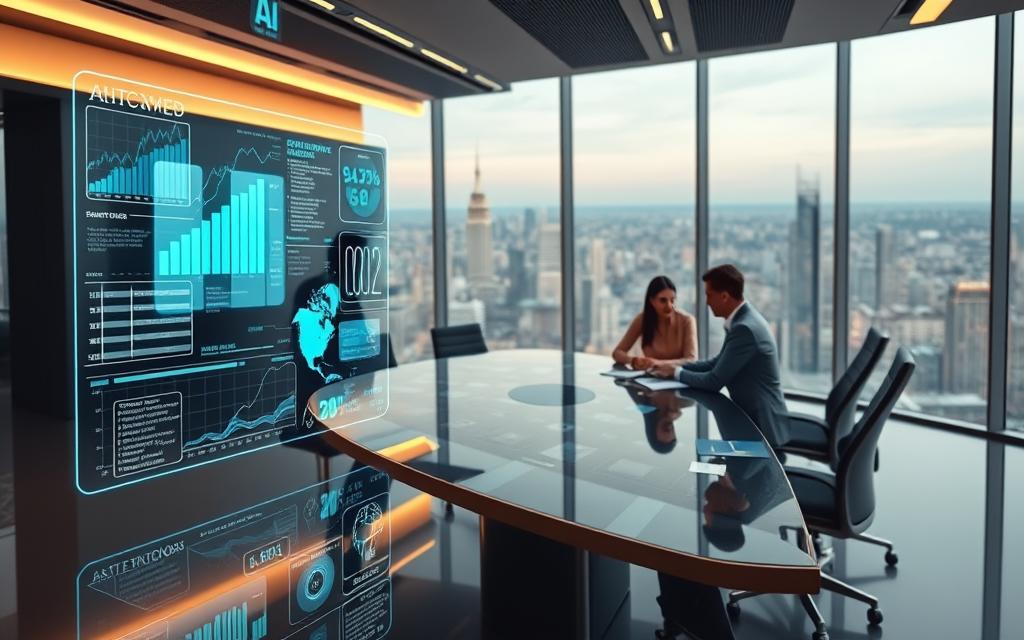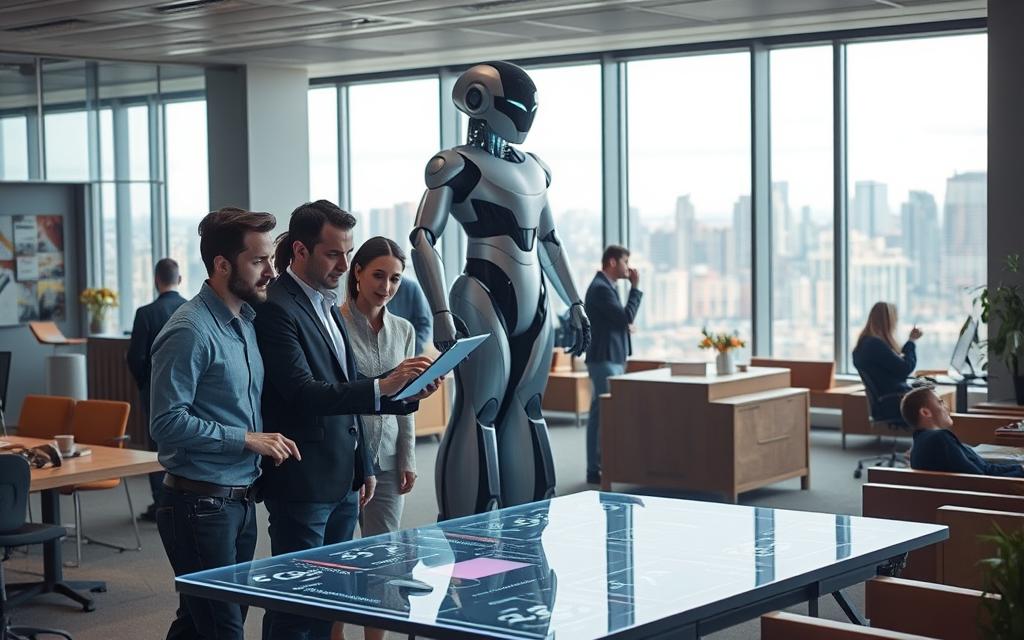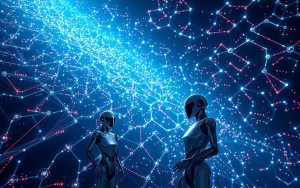Table of Contents
Artificial intelligence is transforming industries worldwide. From automation to decision-making, technologies are reshaping the way companies operate. Research shows 77% of firms now explore AI solutions, with 83% prioritizing it in strategic plans.
The global AI market is projected to grow at 38.1% annually through 2030. McKinsey estimates productivity gains up to 50% in sectors like construction. Yet, ethical concerns remain—85% of Americans advocate for stronger safety regulations.
This article examines both advantages and challenges. Efficiency improvements and cost savings balance against workforce concerns. Understanding this impact helps leaders make informed choices in a fast-evolving landscape.
Introduction: The Transformative Power of AI
Once a theoretical concept, artificial intelligence now drives trillion-dollar economic transformations. Grand View Research projects the global market will hit $1.5 trillion by 2030, fueled by sectors like banking and retail.
The shift from basic automation to human capability augmentation defines modern AI. Emerging technologies analyze data faster than teams of analysts, unlocking opportunities for “super firms.” McKinsey notes banks could create $1 billion+ in value by 2035 through AI-driven fraud detection.
“AI’s productivity gains are not incremental—they’re exponential, rewriting industry standards.”
Small businesses also adapt rapidly. Microsoft found 60% of SMB leaders prioritize AI skills to compete. TD Bank’s mortgage renewal alerts, powered by predictive algorithms, showcase enhanced customer experiences.
| Sector | AI Adoption Rate | Key Use Case |
|---|---|---|
| Banking | 46% | Fraud detection |
| Retail | 38% | Personalized marketing |
| Healthcare | 29% | Diagnostic support |
Yet, concentrated AI advantages raise concerns. Dominant players could monopolize markets, leaving smaller businesses behind. Balancing innovation with equity will shape the future of this revolution.
How Does AI Affect Business for People?
Machine learning now accelerates workflows across industries, reshaping daily operations. Deloitte reports data analysis in mining is 18x faster with ML, while 47% of professionals rely on digital assistants for routine tasks.

Enhancing Productivity and Efficiency
Predictive maintenance systems in manufacturing reduce downtime by 30%, according to machine learning insights. Chatbots manage 10–20x more inquiries than human agents, streamlining customer service.
Samsung’s Galaxy S24 AI transcript assistant exemplifies time-saving tools, converting meetings into notes instantly. McKinsey predicts 1.5% annual productivity growth from such automation.
Personalizing Customer Experiences
Flybits’ AI concierge crafts hyper-personalized banking offers, boosting engagement by 35%. HubSpot’s CRM drafts context-aware emails, leveraging data analysis for higher open rates.
“91% of consumers prefer brands offering tailored recommendations.”
For deeper strategies, explore AI-driven personalization. Yet, IMF warns 40% of jobs face exposure, urging balanced adoption.
AI’s Role in Key Industries
Across critical industries, intelligent systems are driving measurable improvements. These tools optimize workflows, enhance accuracy, and unlock new revenue streams. Leaders leverage data to stay competitive in fast-evolving markets.
Healthcare: Saving Lives and Reducing Costs
Remote patient monitoring systems now alert doctors to anomalies in real time. Clinical AI could save $150 billion annually by streamlining diagnoses and reducing errors. Over 38% of providers use algorithms for faster, more accurate test analysis.
Retail: From Inventory to Customer Engagement
Nike’s recommendation engines boost sales by suggesting personalized products. Walmart’s inventory AI cuts stockouts by 25%, ensuring shelves stay full. The retail AI market will hit $20 billion by 2026, fueled by demand for targeted marketing.
“AI-powered personalization increases conversion rates by 35% in retail.”
Banking: Fraud Detection and Customer Service
Mastercard’s algorithms prevent $600 million in annual fraud through pattern recognition. JPMorgan’s COiN platform reviews contracts in seconds, slashing legal review time. Allstate’s chatbot resolves 50% of customer inquiries without human intervention.
These advancements highlight AI’s transformative potential. Balancing innovation with ethical implementation ensures sustainable growth across industries.
The Benefits of AI in Business
Strategic implementation of machine learning delivers competitive advantages. Organizations now achieve unprecedented precision in operations through real-time data processing. The accounting AI market alone will reach $161 million by 2028, reflecting widespread adoption.

Intelligent systems transform raw information into actionable insights. AIOps platforms already automate 70% of routine IT tasks, freeing teams for complex problem-solving. These advancements create ripple effects across departments and industries.
Data-Driven Decision Making
Salesforce Einstein demonstrates the power of predictive analysis. Its lead scoring system helps sales teams prioritize opportunities with 92% accuracy. This approach reduces guesswork while increasing conversion rates.
John Deere’s agricultural AI boosts farm income by 15% through precise yield predictions. Soil sensors and satellite imagery combine for hyper-local recommendations. Such tools exemplify how machine learning enhances human expertise.
- Unilever cut hiring time by 75% using resume-screening algorithms
- Deloitte’s audit automation handles 80% of compliance checks
- Starbucks Deep Brew optimizes staff schedules based on foot traffic patterns
Cost Reduction and Resource Optimization
DHL’s route optimization AI saves 10% in fuel costs annually. The system analyzes traffic patterns, weather, and delivery windows. These operations improvements demonstrate tangible cost reduction.
“Every 1% efficiency gain in logistics equals $15 billion industry-wide savings.”
Predictive maintenance in manufacturing prevents equipment failures before they occur. This approach reduces downtime by 30% while extending asset lifespans. Such innovations prove that intelligent analysis pays dividends across the value chain.
The most successful implementations combine human oversight with machine learning capabilities. This balanced approach maximizes returns while maintaining quality standards. Continuous improvement becomes systematic rather than sporadic.
The Challenges and Ethical Considerations of AI
Workforce dynamics shift dramatically as algorithms assume tasks once performed exclusively by people. These technologies create efficiency gains but raise profound ethical questions about fairness, security, and human dignity.
Job Displacement and Workforce Transformation
MIT researchers predict 300,000 trucking positions may vanish due to autonomous vehicle technologies. By 2025, 16% of existing jobs could disappear while only 9% emerge as replacements.
The EU AI Act establishes risk categories for workforce impacts. High-risk applications require human oversight and transparency measures. Amazon’s discontinued hiring algorithm demonstrated how bias can creep into automated systems.
- Warehouse automation displaces 20% of manual labor roles annually
- 71% of employees question whether employers will use AI ethically
- Microsoft’s certification programs train workers for AI-augmented roles
Privacy and Security Concerns
IBM’s differential privacy techniques anonymize medical records while preserving research value. Such cybersecurity measures become critical as data collection expands.
Clearview AI’s $9 million GDPR fine highlights facial recognition risks. Anthropic’s Constitutional AI framework embeds safety protocols directly into algorithmic decision-making.
“Responsible innovation requires equal focus on societal impact and technical capability.”
Balancing progress with protection remains key. Organizations adopting these tools must prioritize both performance and human welfare.
AI and the Future of Work
The workplace evolves rapidly as intelligent systems redefine traditional roles. Over 60% of executives now prioritize skills in machine learning during hiring, fueling a $15 billion corporate training market. This shift creates both challenges and opportunities for the modern workforce.

Emerging Roles and Skills
New positions bridge human expertise with algorithmic capabilities. AI trainers fine-tune language models, while ethics auditors ensure responsible deployment. Robotics supervisors manage automated assembly lines, combining technical and managerial skills.
Major firms invest heavily in reskilling:
- PwC upskills 65,000 employees through its AI Academy
- Accenture’s “applied intelligence” program prepares teams for hybrid workflows
- Google’s PAIR initiative researches optimal human-AI interfaces
| Traditional Role | AI-Era Evolution | Key Skills Added |
|---|---|---|
| Quality Inspector | Defect Detection Analyst | AI system validation |
| Content Writer | AI Editor (Duolingo model) | Algorithmic bias review |
| Maintenance Technician | Predictive Systems Supervisor (Siemens) | Sensor data interpretation |
Collaboration Between Humans and AI
NASA’s Mars rover operations demonstrate seamless collaboration. Scientists set goals while AI handles terrain navigation. This model reduces errors by 40% compared to manual control.
“Our teams achieve 2x faster problem-solving when paired with diagnostic algorithms.”
Duolingo’s content creation process blends generative tools with human oversight. AI drafts language exercises, which editors refine for cultural relevance. Such partnerships define the future of productive job environments.
Real-World Examples of AI in Action
From chatbots to predictive analytics, practical applications deliver measurable results. Leading organizations implement these systems to enhance operations and customer experiences. Concrete examples reveal the technology’s transformative potential.

Enhancing Customer Interactions
Bank of America’s Erica assistant processes over 50 million requests annually. This virtual financial guru helps users track spending and pay bills through natural conversations.
Amtrak’s Julie chatbot handles 5 million queries each year. The automated assistant reduces call center volume while maintaining 92% accuracy in trip planning responses.
“Our AI concierge resolves 80% of routine banking inquiries without human transfer.”
AXA’s claims automation uses natural language processing to assess damage reports. The system processes claims 60% faster than manual methods while reducing errors.
Optimizing Industrial Operations
GE’s Predix platform saves $500 million yearly through predictive maintenance. Sensors detect equipment anomalies before failures occur, minimizing downtime in power plants.
- Rolls-Royce monitors 4,000 aircraft engines in real time, preventing 35% of potential mid-flight issues
- Shell’s drilling equipment alerts engineers about wear patterns 30 days before critical failures
- H&M’s inventory systems reduced overstock by 20% through demand forecasting
Domino’s Voice Order achieves 95% accuracy in processing pizza requests. The speech recognition application handles complex topping combinations without human input.
Spotify’s DJ AI curates personalized playlists by analyzing listening history and mood indicators. This feature drives 40% longer user sessions compared to standard recommendations.
Preparing for an AI-Driven Future
Organizations worldwide recognize the need to adapt as intelligent technologies reshape industries. Corporate spending on AI training will reach $3.4 billion in 2024, reflecting urgent skill development priorities. The EU’s AI Liability Directive underscores growing regulatory focus on responsible implementation.
Investing in AI Education and Training
Google’s AI literacy initiative has engaged over 10 million learners through interactive courses. Their curriculum covers foundational concepts to advanced applications, preparing diverse audiences.
Salesforce Trailhead offers specialized modules for CRM automation and predictive analytics. These programs help professionals integrate management tools into daily workflows.
- IBM’s AI Fairness 360 toolkit provides open-source bias detection algorithms
- Northeastern University launched a certification program in AI ethics
- Montreal’s research cluster develops culturally-aware machine learning models
“Effective training bridges technical capability with human judgment for balanced decision-making.”
Building Ethical AI Frameworks
SAP established an independent review board to evaluate algorithm impacts. Their framework assesses fairness across gender, race, and socioeconomic factors before deployment.
The IEEE’s Ethically Aligned Design standards guide developers in creating transparent systems. These principles address accountability gaps in automated decision processes.
| Organization | Initiative | Impact |
|---|---|---|
| IBM | AI Fairness 360 | Reduces bias in 87% of tested models |
| EU Commission | AI Liability Directive | Creates legal recourse for algorithm harms |
| IEEE | Ethical Design Standards | Adopted by 62% of Fortune 500 tech firms |
These efforts demonstrate how frameworks can align innovation with societal values. Continuous improvement ensures technologies benefit all stakeholders equitably.
Conclusion: Embracing AI with Caution and Optimism
Intelligent technologies offer transformative opportunities, with a projected $15.7 trillion economic impact. Yet, workforce transitions demand proactive upskilling. Gartner predicts 80% of enterprises will employ ethics officers by 2026 to guide responsible adoption.
Successful integration hinges on collaboration. Human oversight ensures balanced innovation, while policies must address data privacy and job market shifts. Over 65% of CEOs now prioritize AI investments, signaling its strategic value.
The future belongs to organizations blending automation with human creativity. Continuous learning and ethical frameworks will maximize benefits across industries. With thoughtful implementation, these tools can drive progress without compromising societal values.
FAQ
How does artificial intelligence improve customer service?
AI-powered chatbots and virtual assistants provide instant, 24/7 support, reducing wait times. Machine learning analyzes customer behavior to personalize interactions, improving satisfaction.
What industries benefit most from AI technologies?
Healthcare, retail, and banking see major advantages. Hospitals use AI for diagnostics, stores optimize inventory, and banks enhance fraud detection while automating transactions.
Can AI replace human jobs in business operations?
While automation handles repetitive tasks, new roles emerge in AI management and data analysis. Companies like Amazon combine robotics with human oversight for warehouse efficiency.
How does AI impact marketing strategies?
Tools analyze social media trends and consumer data to create targeted campaigns. Netflix’s recommendation engine boosts engagement by predicting viewer preferences with 80% accuracy.
What cybersecurity risks come with AI adoption?
While AI detects fraud faster, hackers use similar technologies for sophisticated attacks. IBM’s Watson helps businesses strengthen defenses through real-time threat analysis.
What skills will workers need in AI-driven workplaces?
Data literacy, machine learning basics, and adaptability are crucial. Google’s AI certifications help professionals transition into tech-enhanced roles across industries.
How do small businesses implement AI cost-effectively?
Cloud-based tools like Salesforce Einstein offer affordable automation for sales and customer management without heavy infrastructure investment.









